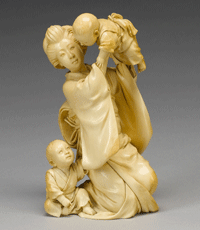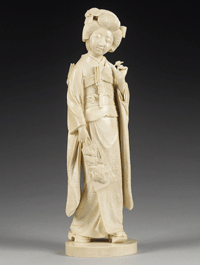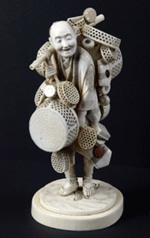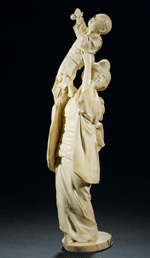|
Japanese Okimono Figures
By Christopher Proudlove
There are many myths in the world of fine art and antiques. It is my
intention to dispel at least some of them. Take Japanese works of art, dating
from the Meiji Period, for example. Already, I can see that glazed look coming
over your eyes. Read on, this is not some highbrow subject only for scholars and
millionaire connoisseurs. Not a bit of it; it's for collectors like you and me.
For a start, the Meiji Period it runs from 1868 to 1912 was named after
the title chosen by the emperor and means "enlightened ruler". The period was
marked by the restoration of power to the emperor after the fall of the
shogunate, by a complete opening to the West, and the adoption of Western
technology, science and to a degree, cultural values. It also corresponds in
broad terms to our own Victorian Era, and just as purists sneered at Victoriana,
so too did they once abhor Japanese works of art from that time. However, in
recent years, collectors and museums have reassessed this view. More has been
learned about the artists of the period and their schools, making it a fruitful
area for the collector.
It was during the Meiji Period that Japan opened her
doors to the West for the first time in 200 years. In 1853, the U.S. Navy's
Commodore Matthew Perry dropped anchor at the entrance to Tokyo Bay and forced
the Japanese to take notice of the outside world. Under threat of a naval
bombardment, Japan finally entered into a trade treaty, giving America a virtual
monopoly with Japan for many years.
Interestingly, many American trading vessels
sailed from New England ports where whaling fleets berthed and whose crews were
only too familiar with the marine ivory scrimshaw carvings. Netsuke,
consequently, became some of the first articles of trade to be exported, and by
the 1870s, netsuke collecting had become popular in the West.
The subsequent
demand for Japanese works of art was immediate. The Japanese were quick to
capitalize on this, and production of a wide range of decorative arts began on a
large scale. The style of these "export" wares differed radically from
traditional ones, however. After all, they had to satisfy what Westerners
thought Japanese arts to be: warlike Samurai warriors, scenes from the country's
mythology, and pretty young courtesans. But the quality of craftsmanship was,
generally speaking, of the very highest order.
Metalworkers, for example,
who were formerly employed producing swords and fittings for the Samurai, began
to fashion decorative pieces, such as figurative sculptures, flower vases and
boxes. One area of the market that in my view remains under appreciated is that
for ivory figures, known as okimono many of which, particularly those of the
Tokyo School, are of exceptionally fine quality. Normally, they depict such
subjects as farmers, fishermen, artisans, young women and children at play.
Occasionally, one finds particularly striking studies of birds, animals and
flowers.
The emergence of okimono is an interesting spin-off from Japan's
exposure to Western culture. Once, the country's traditional form of dress was
the kimono, and it was worn by both men and women. However, it soon became
relegated to ceremonial occasions in favor of more modern fashion. With it went
the traditional accessories like the netsuke (pronounced net-skee), the small
toggle used to fasten a pouch (such as for tobacco) to the belt of the garment.
For years these toggles, usually in wood or ivory, had been skillfully carved by
craftsmen who relied on the work to make a living. So with the demise of the
kimono, they turned their attention to what was by now a lucrative export
market, and netsuke found its way to America and Europe by the shipload.
Market forces decreed that the toggles should be larger, more intricate and
elaborate, to the point where they grew so big, they became purely decorative.
Thus, carvers of netsuke also began to produce what can only be described as
okimono, and there are distinct similarities between the two. Animals and birds,
legendary figures, the martial arts, peasants and farmers all feature strongly
as the subjects of both categories.
Interestingly, the okimono is a vital
element in the inseparable state of everyday life and art in a Japanese house,
and it would be given pride of place in an alcove built especially for it called
a tokonoma. Most Japanese homes, even those with a Western style, have at least
one Japanese-style room, inside which is a tokonoma. Only a few objects are
displayed in it on any one occasion, and these must have connections to each
other and reflect the season of the year.
Now, take the little fellow in the
photo on this page. Standing on his little circular plinth, his inscrutable
smile belying the fact that time has caused him to stoop under the weight of his
burden. This little Japanese figure of a basket seller is so lifelike; one
almost expects him to give you a wave as he marches off across the table top.
But he has stood in that pose for perhaps 100 years, every feature of his little
face and every detail of his baskets clearly defined. The skill it must have
taken to carve such a perfectly detailed little work of art as this should not
be dismissed lightly. Come the auction sale, though, and at £380 ($707), I
thought he was a cheap buy for someone with the cash to spare.
Some of the
most exquisite and most ingenious of all decorative okimono, much of it made
specially for export, are the wonderful articulated models of crayfish, dragons,
serpents and birds that are found in many Western collections. The best of these
are exquisite in workmanship, graceful in design, often strikingly original in
conception, and usually naturalistic in ideal. They constitute a phase of art in
which Japan has few rivals. However, watch for damage on the delicate
constituent parts.
The less well heeled buyer can, with a modicum of
knowledge and an eye for quality carving, still find affordable examples that
are sure to appreciate in value. But like all collectors' items, condition is of
paramount importance. Damage has a dramatic affect on prices. Centrally heated
rooms are also bad news for ivory, which does not take kindly to changes in
temperature. Display it in a glass cabinet kept humid with a small container of
water. And avoid sunlight.
Cotton wool soaked in mentholated spirits is the
best way of cleaning dirty ivory, but be sure not to rub too hard or the fine
patination that comes with age could be lost forever. Restoration should be
carried out only by an expert, and that means it's horrendously expensive.
Exceptionally finely carved figures which, by their nature could not have
been carved from a single tusk, were made from several pieces, and it is here
that the buyer should be wary. That said, complex okimono involving numerous
pieces are somewhat prone to falling apart because the fish glue holding them
will perish with age. The problem can look worse than it is, and a loose arm or
a head or pieces that make up a base can be reassembled using modern adhesive
sparingly.
If loose parts are present, reassembly is perhaps better left to
a specialist. More serious is the possibility that missing parts the intricate
accessories such as tools, arrows, small boxes and so on have been replaced
with something freshly carved. Look for variations in color, grain and texture
of the material employed.
The biggest worry facing a newcomer is the
abundance of fakes that exist. Clever but crooked souls are doing nicely out of
plastic resin copies made from molds which faithfully reproduce not only color
and weight, but also the most intricate of carving, and even the cracks that
appear only with age. The expert can spot them just by touch: ivory feels cold,
plastic does not. The novice should employ an equally simple, though somewhat
more drastic test: heat a pin to red hot and give the suspect piece a prod.
Plastic melts, ivory does not, so pick a hidden spot such as the base. Failing
that, buy only from reputable sources where a guarantee is freely given, either
in conditions of business or on paper.
Buyers should also be wary of falling
foul of the regulations covering the trade in ivory drawn up by CITES (the
Washington Convention on International Trade in Endangered Species of Wild Flora
and Fauna). All import, export and re-export of ivory must be authorized through
a licensing system. The sale of ivory carved 100 or more years ago remains
legal, but legal ivory is indistinguishable from illegal ivory. Always get a
written statement from the seller that clearly states the ivory sold is not
restricted although it is worth remembering that reputable dealers are not
going to risk the considerable fines and effect on their business by handling
ivory of doubtful origin.
Christopher Proudlove has a
background that combines journalism with press and public relations for
Sotheby's and Bonhams, two of the world's three largest fine art auctioneers.
Retaining his principal interest in fine art and antiques, Christopher is now a
consultant specializing in press, PR and marketing for a number of national and
international auctioneers. He lives in North Wales, where Snowdonia meets the
sea. Christopher has been writing about antiques and collecting since 1979, and
his articles have been published in numerous national and regional newspapers
and magazines. He currently writes a weekly newspaper column on collecting and
monthly columns for several lifestyle magazines. He is also the publisher of his
own website at www.WriteAntiques.com.
|

An elegant ivory carving of a woman with her two children; 7.5 in.; some old
damage; Meiji/Taisho Period; sold for $6,047.

A very fine ivory okimono of a standing Geiko, wearing an elegant kimono,
zori, obi, kanzashi and single kushi, holding an ornamental hagoita racket in
her right hand and a small flower in her left, 15.75 inches high, with
incised signature Dohaku Saku; some age cracks; Meiji Period;
sold for
$15,816.

A Meiji Period okimono of a
basketseller, $5,800-$7,800.

A very fine and large (18 in.),
okimono from the Meiji Period of a mother
holding her son above her head, $33,000-$39,000. |